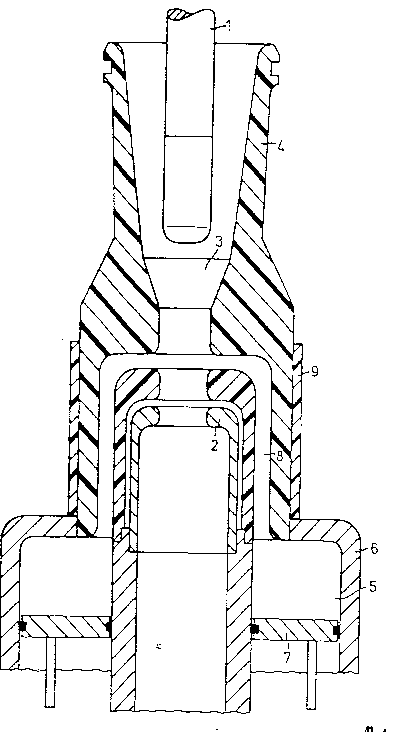Some of the information on this Web page has been provided by external sources. The Government of Canada is not responsible for the accuracy, reliability or currency of the information supplied by external sources. Users wishing to rely upon this information should consult directly with the source of the information. Content provided by external sources is not subject to official languages, privacy and accessibility requirements.
Any discrepancies in the text and image of the Claims and Abstract are due to differing posting times. Text of the Claims and Abstract are posted:
| (12) Patent Application: | (11) CA 2191590 |
|---|---|
| (54) English Title: | COMPRESSED-GAS CIRCUIT BREAKER WITH A NOZZLE MADE OF INSULATING MATERIAL |
| (54) French Title: | INTERRUPTEUR DE PUISSANCE A GAZ SOUS PRESSION, DOTE D'UNE BUSE EN MATIERE ISOLANTE |
| Status: | Deemed Abandoned and Beyond the Period of Reinstatement - Pending Response to Notice of Disregarded Communication |
| (51) International Patent Classification (IPC): |
|
|---|---|
| (72) Inventors : |
|
| (73) Owners : |
|
| (71) Applicants : |
|
| (74) Agent: | SMART & BIGGAR LP |
| (74) Associate agent: | |
| (45) Issued: | |
| (86) PCT Filing Date: | 1995-05-08 |
| (87) Open to Public Inspection: | 1995-12-07 |
| Examination requested: | 2002-03-12 |
| Availability of licence: | N/A |
| Dedicated to the Public: | N/A |
| (25) Language of filing: | English |
| Patent Cooperation Treaty (PCT): | Yes |
|---|---|
| (86) PCT Filing Number: | PCT/DE1995/000631 |
| (87) International Publication Number: | WO 1995033274 |
| (85) National Entry: | 1996-11-28 |
| (30) Application Priority Data: | ||||||
|---|---|---|---|---|---|---|
|
The invention concerns a compressed-gas circuit breaker with two coaxially
disposed contacts (1, 2) at least one of which can be driven to move in the
longitudinal direction, the two contacts delimiting in the break state a
switch path (3). The circuit breaker also has a nozzle (4), made of insulating
material, which is connected to the driven contact (2) and which surrounds at
least part of the switch path (3). The invention calls for a high-strength
plastic tube (9) lying coaxially against the outside of the insulating nozzle
(4) in order to prevent said nozzle (4) from expanding radially as a result of
an increase in quencher-gas pressure.
Interrupteur de puissance à gaz sous pression, comprenant deux pièces de contact (1, 2) disposées coaxialement, dont au moins l'une peut être entraînée en direction axiale, ces deux pièces de contact délimitant, à l'état de coupure, un parcours de commutation (3), et au moins une buse en matière isolante (4) reliée à la pièce de contact mobile (2) et entourant au moins une partie du parcours de commutation (3), caractérisé en ce qu'il est prévu un tube de matière plastique haute résistance (9) s'appliquant sur la périphérie de la buse isolante (4), coaxialement à celle-ci, en vue d'empêcher une expansion radiale de ladite buse (4) consécutivement à un accroissement de la pression du gaz de soufflage.
Note: Claims are shown in the official language in which they were submitted.
Note: Descriptions are shown in the official language in which they were submitted.

2024-08-01:As part of the Next Generation Patents (NGP) transition, the Canadian Patents Database (CPD) now contains a more detailed Event History, which replicates the Event Log of our new back-office solution.
Please note that "Inactive:" events refers to events no longer in use in our new back-office solution.
For a clearer understanding of the status of the application/patent presented on this page, the site Disclaimer , as well as the definitions for Patent , Event History , Maintenance Fee and Payment History should be consulted.
| Description | Date |
|---|---|
| Inactive: IPC from MCD | 2006-03-12 |
| Application Not Reinstated by Deadline | 2005-05-09 |
| Time Limit for Reversal Expired | 2005-05-09 |
| Deemed Abandoned - Failure to Respond to Maintenance Fee Notice | 2004-05-10 |
| Amendment Received - Voluntary Amendment | 2002-08-09 |
| Inactive: Application prosecuted on TS as of Log entry date | 2002-05-21 |
| Inactive: Status info is complete as of Log entry date | 2002-05-21 |
| Letter Sent | 2002-05-21 |
| Request for Examination Requirements Determined Compliant | 2002-03-12 |
| All Requirements for Examination Determined Compliant | 2002-03-12 |
| Inactive: Adhoc Request Documented | 1997-05-08 |
| Deemed Abandoned - Failure to Respond to Maintenance Fee Notice | 1997-05-08 |
| Application Published (Open to Public Inspection) | 1995-12-07 |
| Abandonment Date | Reason | Reinstatement Date |
|---|---|---|
| 2004-05-10 | ||
| 1997-05-08 |
The last payment was received on 2003-04-30
Note : If the full payment has not been received on or before the date indicated, a further fee may be required which may be one of the following
Please refer to the CIPO Patent Fees web page to see all current fee amounts.
| Fee Type | Anniversary Year | Due Date | Paid Date |
|---|---|---|---|
| Registration of a document | 1997-02-03 | ||
| MF (application, 3rd anniv.) - standard | 03 | 1998-05-08 | 1998-04-24 |
| MF (application, 4th anniv.) - standard | 04 | 1999-05-10 | 1999-04-16 |
| MF (application, 5th anniv.) - standard | 05 | 2000-05-08 | 2000-04-18 |
| MF (application, 6th anniv.) - standard | 06 | 2001-05-08 | 2001-04-20 |
| Request for examination - standard | 2002-03-12 | ||
| MF (application, 7th anniv.) - standard | 07 | 2002-05-08 | 2002-04-30 |
| MF (application, 8th anniv.) - standard | 08 | 2003-05-08 | 2003-04-30 |
Note: Records showing the ownership history in alphabetical order.
| Current Owners on Record |
|---|
| SIEMENS AKTIENGESELLSCHAFT |
| Past Owners on Record |
|---|
| HEINER MARIN |
| VOLKER LEHMANN |